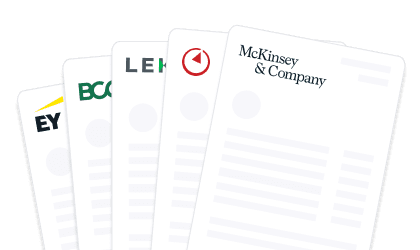How to Answer Customer Segmentation Case Questions in Management Consulting Interviews?
Learn how to ace customer segmentation case questions in management consulting interviews with our comprehensive guide.
Posted April 10, 2025

Stay in the loop. Go places.
Join 100,000+ others and receive free resources, exclusive event invites, and personalized support to reach your goals.
Table of Contents
Customer segmentation is a key element of any successful marketing strategy. Effective segmentation can help businesses better understand their customers, tailor their products and services to meet their needs, and ultimately increase revenue and profitability. As such, it is not surprising that customer segmentation is a common topic in management consulting interviews. In this article, we will discuss everything you need to know to successfully answer customer segmentation case questions during a management consulting interview.
Understanding the importance of customer segmentation in management consulting interviews
Before we dive into the specifics of how to answer customer segmentation case questions, it’s important to understand why this topic is so important in management consulting. Management consultants are hired to provide strategic guidance to businesses looking to improve their operations. Given the critical role that customer segmentation plays in any successful marketing strategy, it is only natural that management consulting interviews would focus on this topic. During these interviews, you can expect to be asked questions about the importance of customer segmentation, as well as how businesses can effectively identify and target their key customer segments.
One of the key reasons why customer segmentation is so important is that it allows businesses to tailor their marketing efforts to specific groups of customers. By understanding the unique needs and preferences of different customer segments, businesses can create targeted marketing campaigns that are more likely to resonate with their target audience. This can lead to increased customer engagement, higher conversion rates, and ultimately, greater revenue for the business.
Another important aspect of customer segmentation is that it can help businesses identify new opportunities for growth. By analyzing customer data and identifying patterns and trends, businesses can uncover new customer segments that they may not have previously considered. This can lead to the development of new products or services that are specifically tailored to these segments, helping the business to expand its customer base and increase its market share.
Key factors to consider when analyzing customer segmentation case studies
When presented with a customer segmentation case study during a management consulting interview, it is crucial to analyze the case from all angles. Some key factors to consider when analyzing these case studies include the overall market size, the competitive landscape, the target customer segments, and the current marketing strategies being employed. It is also important to look for any potential data gaps or inconsistencies that could be impacting the accuracy of the segmentation analysis.
Another important factor to consider when analyzing customer segmentation case studies is the potential for market trends and shifts. It is important to understand how the market is evolving and how this may impact the current segmentation strategy. Additionally, it is important to consider the potential for new competitors to enter the market and how this may impact the current competitive landscape. By taking into account these additional factors, a more comprehensive analysis of the customer segmentation case study can be conducted.
Best practices for conducting research to inform customer segmentation strategies
When developing a customer segmentation strategy, it is important to conduct thorough research on your target customers to ensure that you are making data-driven decisions. This may involve conducting customer surveys, analyzing social media data, or monitoring website analytics. It is also important to keep an open mind and be willing to explore new and innovative research methods that could provide valuable insights into your customer base.
One effective research method is conducting focus groups with your target customers. This allows you to gather qualitative data and gain a deeper understanding of their needs, preferences, and behaviors. Additionally, you can use this opportunity to test out new product ideas or marketing messages and receive immediate feedback from your customers.
Another important aspect of conducting research for customer segmentation is ensuring that your data is accurate and representative of your target audience. This means taking steps to avoid bias in your research methods and sampling techniques, as well as regularly updating your data to reflect changes in your customer base over time.
How to identify and prioritize customer segments for a business
Identifying and prioritizing customer segments is a critical part of any successful marketing strategy. To do so effectively, it is important to consider factors such as customer demographics, psychographics, and behavior. Once these segments have been identified, it is crucial to prioritize them based on their potential value to the business. This may involve analyzing factors such as customer lifetime value, revenue potential, and overall market size.
Another important factor to consider when identifying and prioritizing customer segments is their level of engagement with the business. Highly engaged customers are more likely to make repeat purchases and recommend the business to others, making them a valuable segment to prioritize. On the other hand, customers who are less engaged may require more effort and resources to convert into loyal customers.
It is also important to regularly review and update the identified customer segments and their prioritization. As the market and customer behavior changes, the value and potential of certain segments may shift. By regularly analyzing and adjusting the prioritization of customer segments, businesses can ensure they are effectively targeting the most valuable and relevant customers.
Analyzing customer behavior data to inform segmentation decisions
One of the most effective ways to inform customer segmentation decisions is to analyze customer behavior data. This may involve looking at purchase history, website analytics, or social media engagement. By understanding how customers engage with a business, you can identify patterns that may indicate certain segments are more valuable or engaged than others.
Another important aspect of analyzing customer behavior data is to identify potential areas for improvement in the customer experience. For example, if customers are frequently abandoning their shopping carts on a website, this may indicate a problem with the checkout process. By addressing these issues, businesses can improve customer satisfaction and retention.
It's also important to consider external factors that may impact customer behavior, such as changes in the market or industry trends. By staying up-to-date on these factors and adjusting segmentation strategies accordingly, businesses can better target their marketing efforts and stay ahead of the competition.
Developing effective marketing strategies based on customer segmentation insights
Once customer segments have been identified and analyzed, it is important to develop marketing strategies that are tailored to each segment’s unique needs and preferences. This may involve developing targeted messaging, creating personalized content, or offering promotions that specifically appeal to each segment.
It is also important to regularly review and update these marketing strategies as customer preferences and behaviors may change over time. By staying up-to-date with customer segmentation insights and adjusting marketing strategies accordingly, businesses can maintain a competitive edge and better meet the needs of their customers.
Common challenges faced when answering customer segmentation case questions and how to overcome them
When answering customer segmentation case questions, there are a few common challenges that you may encounter. One challenge is ensuring that your analysis is data-driven and based on accurate information. Another challenge is ensuring that your segmentation strategy is actionable and can be implemented by the business. To overcome these challenges, it is important to perform thorough research, look for any potential data gaps or inconsistencies, and be willing to pivot your strategy if necessary.
Another challenge that may arise when answering customer segmentation case questions is identifying the most relevant variables to use in your analysis. It can be difficult to determine which variables are most important in predicting customer behavior and segmenting the market. To overcome this challenge, it is important to consider both quantitative and qualitative factors, such as demographics, psychographics, and customer behavior. Additionally, conducting surveys or focus groups with customers can provide valuable insights into their preferences and needs.
Tips for presenting your findings and recommendations in a clear, concise manner during consulting interviews
When presenting your findings and recommendations during a management consulting interview, it is important to be clear and concise. This may involve developing clear visuals to support your analysis or breaking down complex information into digestible pieces. It is also important to keep your audience in mind and tailor your presentation to their specific needs and preferences.
Another important aspect to consider when presenting your findings and recommendations is to provide actionable insights. It is not enough to simply present data and analysis, but to also provide recommendations that can be implemented by the client. This may involve outlining specific steps or strategies that the client can take to address the issues identified in the analysis. Additionally, it is important to be confident and assertive in your presentation, while also being open to feedback and questions from the client.
Real-life examples of successful customer segmentation strategies implemented by leading companies in various industries
Finally, it can be valuable to look at real-life examples of successful customer segmentation strategies implemented by leading companies in various industries. Some examples include Netflix’s use of personalized movie recommendations to appeal to different customer segments, or Coca-Cola’s development of different product lines to appeal to different audience demographics. By examining these examples, you can gain valuable insights into how effective customer segmentation strategies can drive business success.
Overall, successful customer segmentation is a critical part of any effective marketing strategy. By understanding the importance of customer segmentation, analyzing case studies from all angles, and developing data-driven strategies, you can demonstrate your expertise in this area during management consulting interviews.
Another example of successful customer segmentation is Amazon’s use of personalized product recommendations based on a customer’s browsing and purchase history. This strategy has helped Amazon increase customer loyalty and drive sales by providing a tailored shopping experience for each individual customer.
In the healthcare industry, companies like Pfizer have implemented customer segmentation strategies to target specific patient groups with personalized marketing messages and product offerings. This approach has helped Pfizer increase sales and improve patient outcomes by providing targeted solutions for different medical conditions and patient demographics.



















